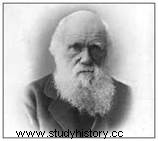 British naturalist, Charles Darwin is certainly not the inventor of the theory of evolution but his work on theorigin of species and his theory of natural selection gave a new measure to evolutionism. It becomes the avatar of this scientific theory which considers that species evolve over time and gradually generate new species or disappear. The most emblematic case is obviously the common ancestor between humans and monkeys. Between scientific progress, spiritual questioning and ideological recuperation, discover the genesis of the most moving theory of the 19th century.
British naturalist, Charles Darwin is certainly not the inventor of the theory of evolution but his work on theorigin of species and his theory of natural selection gave a new measure to evolutionism. It becomes the avatar of this scientific theory which considers that species evolve over time and gradually generate new species or disappear. The most emblematic case is obviously the common ancestor between humans and monkeys. Between scientific progress, spiritual questioning and ideological recuperation, discover the genesis of the most moving theory of the 19th century.
Charles Darwin inventor of the theory of evolution?
Charles Darwin was born on February 12, 1809 in England. After unfinished medical studies, he became a pastor. Darwin frequented scientists, such as geologist Adam Sedgwick and naturalist John Stevens Henslow, and quickly became passionate about the study of species. Many authors have supported the idea that species can transform. When Darwin was studying, this current, already very present, stood up to the fixists who considered that no species had appeared since the divine Creation. The most famous of evolutionists is then the French Lamarck who explains that by an internal will living beings manage to develop new organs adapted to their needs such as for example the neck of the giraffe which would have lengthened to catch higher leaves.
Darwin is a pure product of the English scholarly bourgeoisie, his two grandfathers having been very involved in the anti-slavery society and his paternal grandfather Erasmus Darwin himself having published in 1794 a substantial work defending the evolutionist theses:Zoonomy or Laws of organic life. In the 1850s, even before the release of Darwin's theory, the biologist Huxley and the paleontologist Owen openly clashed over the link between humans and apes. Their debate is relayed by the press and divides the public. However, if the work of Darwin did not inaugurate the debate, it is clear that it has until today transformed our relationship with humans. And yet nothing seemed to predestine this mediocre pupil that was Darwin to surpass Lamarck in fame!
A student in the footsteps of Alexander Von Humboldt
Darwin received an education that he himself considered mediocre at the boarding school of Shrewsbury School, where he entered at the age of 9. However, the child is already passionate about all kinds of experiments and even has a small laboratory at home. His often smelly experiments have earned him the nickname "Gas".
In 1825 he entered medical school in Edinburgh, where his older brother was already. The medical branch becomes a family specialty. This faculty is very famous but in fact the level of the teachers has fallen well below the reputation of the establishment, pushing some students to take additional courses in private establishments.
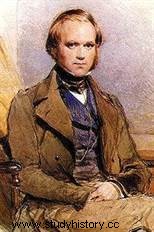
The result of these medical studies is mixed, he certainly acquires skills, even seeing a few patients during a family stay. But he is traumatized by the dissections and especially by two operations which he attends. Operations on children, without anesthesia. But Edinburgh is above all an opportunity for Darwin to better train himself in the natural sciences, which he chooses as an option from the 2nd year. He also joined a student association, the “Plinian Natural History Society” which debates political and scientific themes. Above all, he met Robert Grant, a doctor and zoologist specializing in the anatomy of invertebrates who had studied in Paris with Cuvier and Geoffroy Saint-Hilaire. This man is passionate about Lamarck and an amateur of the works of Erasmus Darwin, he pushes Darwin to deepen the theme of the transmutation of species. Darwin will always remain distant from the idea of internal thrust specific to Lamarckism, but even if the work of his grandfather seems to him very speculative, he will remain forever impregnated with transmutation and its justification!
He left Edinburgh in 1827, made a brief trip to Paris and returned home where he spent his time hunting, much to the chagrin of his father who sent him to Cambridge to become a reverend. A situation that does not necessarily displease Darwin:if he can doubt the credo, he is a believer and after all many naturalists were clergymen. During this time at Cambridge Darwin says he wasted his time, although two points made his stay in this school prolific:
- The excellent botany courses of Reverend Henslow with whom he formed a true friendship.
- A Geological Expedition in North Wales with Adam Sedgwick. This man is an ardent fixist but introduced Darwin to the real scientific process:grouping facts to draw laws or general conclusions.
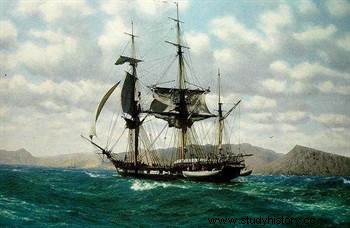
Darwin was a fervent admirer of Alexander Von Humboldt (1769-1859), a great German explorer and theoretician who, among other things, traveled extensively in South America and left scientific and biographical works . Darwin also wants to go on an expedition to the Canary Islands. He is helped in this by Henslow, contacts are even made with London merchants to try to find a ship. Then came the opportunity for the Beagle !
Captain Fitz Roy is looking for a naturalist and gentleman companion for a 2-year expedition to South America. At 22 Darwin presents himself, is accepted and manages to convince his father. The expedition had three goals:to improve the maps of South America, to survey the coasts of Patagonia, Tierra del Fuego and the Falkland Islands and finally to record weather conditions, tides and winds. All to identify the best trade routes and landing points for the expansion of British maritime trade.
The Beagle is a small boat 27m long, Darwin's cabin is 3m x 3.5m and he shares it with 19 year old John Lort Stokes assistant surveyor. Low ceiling, 3 chairs, 1 table and 2 hammocks. They have lunch in the captain's cabin and benefit from a 245-volume library equipped with measuring instruments. A total of 64 passengers including an artist, a doctor, an instrument maker, servants and 3 natives of Tierra del Fuego brought back by Fitz Roy from a previous voyage, presented to the English sovereigns, educated at the captain's expense and that the 'we want to reintroduce them into their tribes to make them vectors of evangelization and civilisation. The departure took place on December 27, 1831 for a journey that lasted 4 years and 9 months.
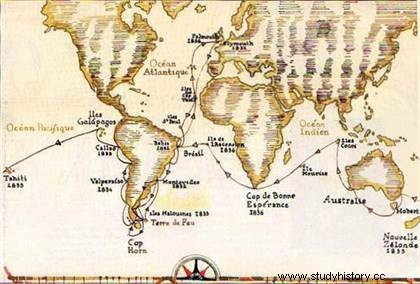 At each stop Darwin sets out to explore and collect specimens of fauna and flora, fossil and lithic samples. .. He observes the habits of animal species, describes them, compares them with similar species from other regions… He studies the contents of their stomach, naturalizes them… And keeps the metropolis informed by regularly sending reports and samples to Henslow who is responsible for making known the elements collected. He reads the Principles of Geology a lot. by Charles Lyell who convinces him that the changes in the fauna must have taken place gradually, over a long period of time, because of the geological changes of the surface of the earth according to laws still in action. Darwin never stopped looking for the origins of mutations and the gradual disappearance of species. He agrees with Lyell on the fact that simple changes such as the introduction of a new species can be the cause of the disappearance of another species:the sheep in Latin America encroaches on the territory of the guanaco and threatens its survival by example.
At each stop Darwin sets out to explore and collect specimens of fauna and flora, fossil and lithic samples. .. He observes the habits of animal species, describes them, compares them with similar species from other regions… He studies the contents of their stomach, naturalizes them… And keeps the metropolis informed by regularly sending reports and samples to Henslow who is responsible for making known the elements collected. He reads the Principles of Geology a lot. by Charles Lyell who convinces him that the changes in the fauna must have taken place gradually, over a long period of time, because of the geological changes of the surface of the earth according to laws still in action. Darwin never stopped looking for the origins of mutations and the gradual disappearance of species. He agrees with Lyell on the fact that simple changes such as the introduction of a new species can be the cause of the disappearance of another species:the sheep in Latin America encroaches on the territory of the guanaco and threatens its survival by example.
The collection of key elements in the career of the young naturalist
The study of atolls and their formation is a founding element in Darwin's scientific reputation. His explanations are still valid today. He explains the formation of atolls by the sinking of volcanic islands around which a coral reef continues to proliferate. The barrier survives while the volcano disappears, the coral does not proliferate in the center of the atoll where the water is too calm. In this he contradicts Lyell who recognizes Darwin's theory.
 On his return, Darwin will publish various publications on this subject which establish his reputation and open the doors of the Society to him. Geologist of which he became secretary. But it is with the Galapagos Islands that he will find the key elements that will forge his theory. He notes that on these recent volcanic islands (resulting from a hot spot, estimated at 5 Ma) there are animal populations that are very close and yet easily distinguishable and above all endemic.
On his return, Darwin will publish various publications on this subject which establish his reputation and open the doors of the Society to him. Geologist of which he became secretary. But it is with the Galapagos Islands that he will find the key elements that will forge his theory. He notes that on these recent volcanic islands (resulting from a hot spot, estimated at 5 Ma) there are animal populations that are very close and yet easily distinguishable and above all endemic.
Darwin will describe and bring back several specimens of turtles. But above all he will study and collect many finches which diverge from those present on the continent, and which differ from each other, by the shape of their beak. A great variety of form induced by a diversity of food following the colonization of many ecological niches in these virgin islands. It is not known whether Darwin immediately understood that he was dealing with the results of the radiation of the same species and its transmutation into several different species.
Perhaps at this point in his journey Darwin only saw the variation of the same species to fit as already agreed by Lyell. But the fact is that on his return these birds will be studied by John Gould who will affirm that they are different species, which proved decisive in the ripening of the Darwinian theory!
Darwinism and natural selection
The Beagle landed on the English coast on October 2, 1836. On his return Darwin entrusted almost all of his samples to the most qualified people to study them:Henslow for the plants, Owen for the fossils, John Gould for the birds... multiple publications that Darwin brought together in a book, Zoologie du voyage du Beagle whose volumes appeared from 1838 to 1843. It was also in 1838 that he became secretary of the Geological Society for its work on the atolls. In addition to his theory on transmutation Darwin will take care to make some other scientific publications so that we cannot question his skills when he publishes his main thesis. He thus worked on earthworms but also and above all on barnacles, with a new species that he had brought back from Latin America. His work on corals and barnacles earned him the Royal Medal!
Upon his return he also wrote his travel diary which was published in 1839 and was part of his fame. He also wrote his famous notebooks in which he gradually developed his theory. A geology notebook, 4 on the transmutation of species and 2 on Man and the spirit.
Darwin is obsessed with the mutation of species, for his study he breeds plants and pigeons of all kinds and takes a close interest in their behavior and variations. He learns a great deal about artificial selection, the way humans choose between variations of the same species. It sends printed questionnaires to breeders and gardeners. Finally, reading Malthus makes him realize that any species could grow indefinitely if there were not the barrier of food availability which induces a struggle between individuals. Malthus used Nature to justify a social system rejecting the welfare state which only fuels impoverishment. Taking up the concept, Darwin transposes this social doctrine into the natural sciences. The struggle between individuals must regulate the population. He deduces his theory on the principles of natural selection:
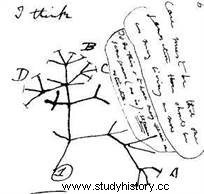
- If this variation is embarrassing for the animal, it is likely to die early or not find a sexual partner. Thus his descendants are negligible or nil and the variation disappears with him.
- If a variation allows animals to survive an ecological crisis or have more sexual partners then their offspring will be more numerous and the variation will spread.
- From variation to variation, a population can move further and further away from the original species to the point of forming a new species.
But Darwin does not yet have all the elements for his theory to be infallible. For example, he does not know the origin of the variations and does not have a type line, fossil or living, proving the progressive differentiation from one species to another.
However, he tested his theory by debating it with learned friends whom he met at his house in Downe, Kent, two hours from London. But among these acquaintances is Alfred Rund Wallace, naturalist and hunter of rare species on behalf of collectors. The latter also wondered about the evolution of species and prepared an article which he sent to Darwin in 1858. Wallace's theory, which is his work, is very similar to Darwin's! In order not to have the rug pulled from under the foot in the field of scientific publication, Darwin was forced to prematurely publish an extract from his work on July 1, 1858. But the elements presented were met with general indifference and it was necessary to wait for the complete publication on November 24, 1859 for the debate to rise!
If Darwin chose not to deal with Man, it is all the same around him that all the debate is tied since Darwin's theory considers everything living things from a common ancestor, gradually differentiated into various species by natural selection. Darwin will not feel able to hold an oratorical joust and will generally content himself with answering the attacks in the reprints of his work. But others will take it upon themselves to defend it in public places, in learned societies but also in academia, such as in the person of Huxley, old enemy of old paleontologist Owen! He will be "Darwin's bulldog"! If the theory leads to an outcry among creationists, it is notable that evolution was already a concept that was beginning to take root in scientific circles and that it was the mechanism that was no longer subject to debate.
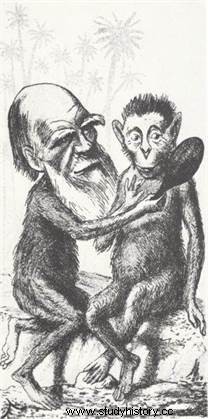
So when the theory arrives in France, Darwin's theory leads above all to a strengthening of Lamarckism! Aware of the interest aroused by the place of Man in the animal kingdom, Darwin devoted a book to him published in 1871: The filiation of Man and the selection linked to sex . Its goal is then to desacralize Man considered by many, even among evolutionists, as apart because endowed with a consciousness of divine essence. Darwin's work will be to study the physical expressions of feelings, to see that they are the same between the different human races (for this he sends numerous questionnaires to missionaries and governors throughout the Empire) and to compare them with his work on the expression of emotions in animals. He deduces that in animals as in humans there is the same range of emotions, often physically expressed in a close way. Its purpose is to show that many behaviors, even social ones, are inherited, resulting from instinct acquired at a very early stage of our evolution. More than the origin of the species, this book is the real reason for the many caricatures of Darwin as an ape-man circulating at the end of the 19th and the beginning of the 20th century.
Darwin and the theory of the origin of species
Darwin's theory implies that only the line of those who are best able to survive in times of crisis (natural selection) and/or most able to survive survives. reproduce (sexual selection). Inspired by the sociology of Malthus, this theory returns to sociology through authors like Galton (cousin of Darwin) who founded in 1908 a “society of eugenic education” with Leonard Darwin (eldest son of Darwin). Eugenics is the desire to allow superior beings the possibility of supplanting, socially or even sexually, the weakest beings. And thus not to stop the complexification of the living at work since the origins. Darwin himself seems to partly adhere to this movement.
Although Darwin sometimes tended to temper these remarks by specifying that social cohesion is one of the forces developed by the species to survive, only these lines remain in The Descent of Man and the sexual selection are one of the bases of social Darwinism.

Eugenics can take various forms according to two trends that are still present today:"positive" eugenics, which consists of valuing superior beings (sperm bank, equality of chances at school, etc.) and “negative” eugenics, which consists in neutralizing the defects of the species (authorization in France of abortion for medical reasons; during totalitarian regimes:sterilization of the sick, regulation of sexual relations between races, elimination of races deemed the most inferior…)
Alas, as Nietzsche wrote in The Twilight :The struggle for existence " unfortunately ends in a way contrary to that which the school of Darwin desired, to that which we might dare -to be desired with it:I mean to the detriment of the strong, the privileged, the happy exceptions. Species do not grow in perfection:the weak always end up making themselves masters of the strong – it is because they have the greatest number, they are also more cunning .
The eternal question is who are the strong ones to select? Denis Buican, author on the subject, concludes on the great massacres of Hitler and Stalin:"It was the selection of the worst... and of the worst torturers... and, moreover, often to the applause of the feeble-minded , even more numerous than the sadists. »In conclusion it appears that the work of Darwin (died April 19, 1882) if it does not inaugurate the theory of evolution, gives it credibility by providing an explanation rational of its mechanisms. A judicious theory largely confirmed and completed today thanks to the progress of genetics. But a theory that leads to a desacralization of Man. Theory born of sociological studies which returns to the sphere of sociology with a desire to improve humanity but which unfortunately often materializes only for the benefit of capitalist spheres profiting from the struggle for work, or for the benefit of totalitarian regimes based on a struggle between races or between classes.
Bibliography
- Gayon Jean, Darwin and after Darwin:a history of the hypothesis of natural selection, Paris, Editions Kimé, 1992
- Georges Bringuier, Charles Darwin:Traveler of Reason. Private, 2012.
- Lecointre Guillaume (sdd), Critical Guide to Evolution. Belin, 2009.
- Darwin Charles (edition and choice of texts by Jérôme Picon), the origin of species, Paris, Flammarion, 2009.
